Sakado Castle
-Irreconciable conflict after god of war (8) suspension bridge in the sky-
Overview
Name: Sakado castle / Sakato castle (Sakado-jo / Sakato-jo)
Alias:
Place: Sakado Minamiuonuma city, Niigata
Type: Mountain Castle
Built: 14th century
Remaining remnants: Stone walls, clay walls and moats
Title:
Brief History
Continued from Part 7
Sakado castle (坂戸城) is located at the top of Sakado-yama mountain, one of over 400 meter from its hillside at the east of central Minani Uonuma city. Uonuma area is a narrow and long basin spreads along with Uono-gawa river over 30 kilometer, a large tributary of Shinano-gawa river. Sakado-yama mountain itself protrudes into the center of the valley from southward, and from the top of the mountain whole part of Uonuma basin is seen.
The south edge of Uonuma basin continues to the side of Tanigawadake mountain, a mountainous border separates Kanto plain and Niigata area. Mikuni Kaido road passes Uonuma basin and crosses Mikuni-Toge pass had been an important road connecting Niigata area and Kanto plain, and now Kanetsu highway and Joetsu Shinkansen train still runs this basin. Utilizing its good soil and pure water, today Uonuma area is known for its high quality rice.
In Kamakura era, Echigo province (Niigata prefecture) was directly governed by Hojyo clan, a virtual leader of Kamakura Shogunate after extinguishment of Minamoto clan. After the fall of Kamakura Shogunate Echigo province was once held by Nitta clan which activated at anti Shoguate campaign under the South Court lead by Emperor Godaigo (1288-1339).
But after the establishment of Muromachi Shogunate, Nitta clan in Echigo province was attacked by Shogunate army, then Uesugi clan which was the close relative of Takauji Ashikaga (1305-1358) who was the founder of Muromachi Shogunate was appointed as the governor of Echigo province.
Uesugi clan took Nagao clan to Echigo province as a deputy governor. Nagao clan was originally a descendant of Taira clan, and once almost lost their territory by an political conflict under Kamakura Shogunate then served to Uesugi clan. In the latter half of 14th century, Nagao clan separated into three houses, it mean Fuchu Nagao clan at current Joetsu city, Koshi Nagao clan at current Nagaoka area, and Ueda Nagao clan resided at Uonuma basin.
As Joetsu area was the capital of Echigo province at that area, Fuchu Nagao clan became the highest position and succeeded deputy governor position. Ueda Nagao clan and Koshi Nagao clan governed middle part of Echigo province under Fuchu Nagao clan. Considering its location small castle might have already existed, but Ueda Nagao clan built Sakado castle in earnest and used it as their residence.
In the beginning of 15th century, Tamekage Nagao, (1489-1543), the leader of Fuchu Nagao clan and father of Kenshin Uesugi (153-1578), revolted against its master Uesugi clan twice and seized the authority of Echigo province. Ueda Nagao clan supported the rebel of Tamekage Nagao, and accepted his daughter as the wife of its next leader Masakage Nagao (1526-1564).
In 1548, Kenshin Uesugi succeeded the leader of Nagao clan from his brother Harukage Nagao (1509-1553). Masakage Nagao once opposed to Kenshin, but was attacked by the army of Kenshin and subordinated. Since then Masakage supported the activity of Kenshin as a major retainer, and sent his son Kagekatsu Uesugi (1556-1623) as an adopted son of Kenshin who did not marry and had no son.
As Kenshin repeatedly made expedition to Kanto region to confront with Hojo clan, the warlord of Sagami province (Kanagawa prefecture) held major part of Kanto region, Uonuma area became an important area to support the march of Uesugi army and also to prevent counter attack of Hojo army. Under the order of Kenshin, Masakage Nagao improved military roads toward Kanto region and surrounding castles including his main base Sakado castle.
Sakado castle consist of many narrow flat terraces spread over the ridges continues toward north, southeast and southwest from its peak. Central area called as Mujyo is a round shaped area of 20 meter diameter, and now used as a ground of shrine. Several large terraces are built surrounding this main area, and later stone walls were added under Hori clan at the entrance to these core area.
Ahead of the curved ridge continues toward southeast ward, three is an another peak almost same height as the main peak, and a skinny ridge over 100 meter long connects these two peak. On the top of this another peak there is another large flat area called as Ojiro, and a shaped watchtower basement still remains. A curved skinny ridge connecting two sheer peaks looks like a suspension bridge in the sky and is quite breathtaking view.
At the north of core areas there is a layer of flat terraces spreads over the slope, and another line of narrow flat terraces continues over 200 meter. As Sakadoyama mountain is an independent mountain and whole part of hilltop area is protected by sheer cliff, Sakado castle consists of just flat lands separated by dry wall but had an excellent ability of defense.
Residence of the lord and castle town existed at the western hillside between the mountain and Uono-gawa river. Ruin of water moat in front of hillside area still remains in front of the mountain. Although the castle had remarkable defense facilities, its size and over 400 meter height made it impregnable fortress, later proved in actual combat.
In 1564, Masakage Nagao draw to die in the accident of play at a pond. According to the tale it was a self-sacrificing plot of Sadamitsu Uesugi (?-?) who was the regent of Kenshin Uesugi, to remove Masakage Nagao who intended rebel to Kenshin again. But there is no evidence to prove the truth of this story except for the cause of death of Masakage.
After the death of Masakage Nagao, Kagekatsu Uesugi succeeded Ueda Nagao clan keeping the place of an adopted son of Kenshin Uesugi. Kenshin also had another adopted son Kagetora Uesugi (1554-1579), who was the people of Hojo clan and accepted when Kenshin Uesugi and Hojo clan allied in 1568. Kenshin and Hojo clan soon broke but Kenshin did not kill or return Kagetora Uesugi as an adopted son.
In March 1578, Kenshin Uesugi suddenly died in ill not showing which of Kagekatsu Uesugi or Kagetora Uesugi succeeded Uesugi clan. In May an internal conflict between Kagekatsu and Kagetora named as “Otate-no-Ran” started, and of course Ueda Nagao clan and its main base Sakado castle strongly supported Kagekatsu Uesugi.
As Kagekatsu Uesugi resided at Kasugayama castle (Niigata prefecture), the main base of Uesugi clan at Joetsu area, Ueda Nagao army was needed to protect themselves and support to their master at distant area. At first both territory was divided by Kagetora Uesugi army, but Kagekatsu Uesugi (Niigata prefecture) turned Nomine castle at the middle of both area and opened communication road.
As Kagetora Uesugi was a people of external lord Hojo clan, majority of local lords in Echigo province belonged to Kagekatsu Uesugi. But Kagetora Uesugi was supported by external powers, including his family Hojo clan and its ally Katsuyori Takeda (1546-1582), the successor of Shingen Takeda (1521-1573) who was the warlord of Kai province (Yamanashi prefecture) and fatal rival of Kenshin Uesugi.
Based on the request from Hojo clan, Katsuyori Takeda lead Takeda army and proceeded to Echigo province from Shinano province (Nagano prefecture). Kagekatsu Uesugi was forced to the corner. But utilizing financial difficulty of Takeda clan after the defeat at the battle of Nagashino in 1575, Kagekatsu could turn Katsuyori Takeda to his side under the condition ceding the territory and money in June 1578.
However, next Hojo clan itself sent army to Echigo province from Mikuni Toge pass to rescue Kagetora Uesugi besieged at Otate castle (Niigata prefecture). Even though lacked main force, Hojo army broke the defense line of Ueda Nagao clan at Uomuma area including Arato castle (Niigata prefecture) and captured Kabanosawa castle (Niigata prefecture), just at 5 kilometer west of Sakado castle in August.
Next Hojo army encircled Sakado castle. Once Sakado castle was lost, Kagekatsu Uesugi lost its main territory and there would be no supply of materials or soldiers to Kasugayama castle. Furthermore, retainers of Kagekatsu except for Ueda Nagao clan look at inferior situation and might turn to Kagetora Uesugi. The army of Kagekatsu just before collapse then Kagekatsu was forced to the former again at more serious situation.
However, secure Sakado castle stood against overwhelming Hojo army for several months, losing the commander of reinforcement army sent from Kagekatsu Uesugi. Sakado castle was totally secured sheer wall and only connected with narrow roads, and Hojo army could not use forcible attack to the castle.
The only possible way to fall this castle is starving out tactics, but as Hojo clan attacked the castle after rice harvest and castle side could prepare supply well. Furthermore, Uonuma area is one of the heaviest snow area in Japan, and once winter comes Hojo army could not transport their supply well. The climate was colder in 400 years ago and October was the start of heavy snow season.
After three month siege of Sakado castle, the winter came to Uonuma area. Main army of Hojo clan was preparing for the invasion into Echigo province but gave up it considering the possibility of stay at heavy snow. Vanguard of Hojo army was left behind at snowy Uomuna area without supply of materials, then could not move from Kabanosawa castle.
Looking at this opportunity, Kagekatsu Uesugi started counter attack both at Joetsu area and Uomuna area. Utilizing both of starvation tactics and forcible attack, Kagekatsu gradually suppressed Kagetora Uesugi besieged at Otate castle and fell it in February 1579. Kagetora Uesugi ran to Samegao castle (Niigata prefecture) but was rebelled by the commander then died in the castle.
At the same time, Nagao Ueda army attacked Kabanosawa castle and recovered it, then expelled Hojo army from Uonuma area in February. In March Hojo army again intruded into Uonuma area, but Kagetora Uesugi already died then Hojo clan soon retreated from Echigo province. At last Kagekatsu Uesugi succeeded Uesugi clan overcoming internal conflict.
No matter what excellent castle it is difficult to stand against overwhelming army long time and reverse situation. But under the condition of Uonuma area at that time in that half of the year is shut down by heavy snow, Sakado castle fully demonstrated its toughness against Hojo army and reversed the situation. Same as its shape, Sakado castle was a suspension bridge for Kagekatsu connecting to the future.
After the cease of internal conflict Sakado castle was continuously used as a base of Uesugi clan, but in 1598 Kagekatsu was transferred Aizu basin Toyotomi government. After Uesugi clan, Hideharu Hori (1576-1606) was appointed as a lord of Echigo province, and Hideharu placed his important retainer Naoyori Hori (1577-1639) as the commander of Sakado castle.
Naoyori reformed hilltop area and hillside residence building stone walls. But in 1608 Naoyori was transferred to the lord of Iiyama castle (Nagano prefecture), then Sakado castle was abolished at this time. Muikamachi town at the side of Sakado castle prospered in Edo era as a river port of Uono-gawa river connected to Mikuni Kaido Road.
Now all building was lost but terraces at hilltop area well remains. As castle site has brilliant scenery of whole direction, it now becomes a hiking course of local people. It is necessary to walk up tough slope and steps over 30 minutes to reach the peak, but magnificent view from the peak is worth more than hard way.
Standing at the castle site over 500 meter long and being isolated in the sky, pressure from attacking force at hillside is not imagined, and this might enabled desperate defense battle against overwhelming enemy.
20 minutes walk from JR East Joetsu-sen line /Hokuetsu-Kyuko line Hokuhokusen line Muikamachi station to hillside entrance. 10 minutes drive from Kanetu-Jidoshado Expressway Muikamachi interchange to hillside parking. 60 minutes walk from hillside entrance to hilltop castle.
Arato Castle -Irreconciable conflict after god of war (7) assault of Hojo army-
The south edge of Uonuma basin continues to the side of Tanigawadake mountain, a mountainous border separates Kanto plain and Niigata area. Mikuni Kaido road passes Uonuma basin and crosses Mikuni-Toge pass had been an important road connecting Niigata area and Kanto plain, and now Kanetsu highway and Joetsu Shinkansen train still runs this basin. Utilizing its good soil and pure water, today Uonuma area is known for its high quality rice.
Three families of Nagao clan
In Kamakura era, Echigo province (Niigata prefecture) was directly governed by Hojyo clan, a virtual leader of Kamakura Shogunate after extinguishment of Minamoto clan. After the fall of Kamakura Shogunate Echigo province was once held by Nitta clan which activated at anti Shoguate campaign under the South Court lead by Emperor Godaigo (1288-1339).
But after the establishment of Muromachi Shogunate, Nitta clan in Echigo province was attacked by Shogunate army, then Uesugi clan which was the close relative of Takauji Ashikaga (1305-1358) who was the founder of Muromachi Shogunate was appointed as the governor of Echigo province.
Uesugi clan took Nagao clan to Echigo province as a deputy governor. Nagao clan was originally a descendant of Taira clan, and once almost lost their territory by an political conflict under Kamakura Shogunate then served to Uesugi clan. In the latter half of 14th century, Nagao clan separated into three houses, it mean Fuchu Nagao clan at current Joetsu city, Koshi Nagao clan at current Nagaoka area, and Ueda Nagao clan resided at Uonuma basin.
Relationship of Kenshin Uesugi and Ueda Nagao clan
As Joetsu area was the capital of Echigo province at that area, Fuchu Nagao clan became the highest position and succeeded deputy governor position. Ueda Nagao clan and Koshi Nagao clan governed middle part of Echigo province under Fuchu Nagao clan. Considering its location small castle might have already existed, but Ueda Nagao clan built Sakado castle in earnest and used it as their residence.
In the beginning of 15th century, Tamekage Nagao, (1489-1543), the leader of Fuchu Nagao clan and father of Kenshin Uesugi (153-1578), revolted against its master Uesugi clan twice and seized the authority of Echigo province. Ueda Nagao clan supported the rebel of Tamekage Nagao, and accepted his daughter as the wife of its next leader Masakage Nagao (1526-1564).
In 1548, Kenshin Uesugi succeeded the leader of Nagao clan from his brother Harukage Nagao (1509-1553). Masakage Nagao once opposed to Kenshin, but was attacked by the army of Kenshin and subordinated. Since then Masakage supported the activity of Kenshin as a major retainer, and sent his son Kagekatsu Uesugi (1556-1623) as an adopted son of Kenshin who did not marry and had no son.
As Kenshin repeatedly made expedition to Kanto region to confront with Hojo clan, the warlord of Sagami province (Kanagawa prefecture) held major part of Kanto region, Uonuma area became an important area to support the march of Uesugi army and also to prevent counter attack of Hojo army. Under the order of Kenshin, Masakage Nagao improved military roads toward Kanto region and surrounding castles including his main base Sakado castle.
Structure of Sakado castle
Sakado castle consist of many narrow flat terraces spread over the ridges continues toward north, southeast and southwest from its peak. Central area called as Mujyo is a round shaped area of 20 meter diameter, and now used as a ground of shrine. Several large terraces are built surrounding this main area, and later stone walls were added under Hori clan at the entrance to these core area.
Ahead of the curved ridge continues toward southeast ward, three is an another peak almost same height as the main peak, and a skinny ridge over 100 meter long connects these two peak. On the top of this another peak there is another large flat area called as Ojiro, and a shaped watchtower basement still remains. A curved skinny ridge connecting two sheer peaks looks like a suspension bridge in the sky and is quite breathtaking view.
At the north of core areas there is a layer of flat terraces spreads over the slope, and another line of narrow flat terraces continues over 200 meter. As Sakadoyama mountain is an independent mountain and whole part of hilltop area is protected by sheer cliff, Sakado castle consists of just flat lands separated by dry wall but had an excellent ability of defense.
Residence of the lord and castle town existed at the western hillside between the mountain and Uono-gawa river. Ruin of water moat in front of hillside area still remains in front of the mountain. Although the castle had remarkable defense facilities, its size and over 400 meter height made it impregnable fortress, later proved in actual combat.
Two adopted son of Kenshin Uesugi
In 1564, Masakage Nagao draw to die in the accident of play at a pond. According to the tale it was a self-sacrificing plot of Sadamitsu Uesugi (?-?) who was the regent of Kenshin Uesugi, to remove Masakage Nagao who intended rebel to Kenshin again. But there is no evidence to prove the truth of this story except for the cause of death of Masakage.
After the death of Masakage Nagao, Kagekatsu Uesugi succeeded Ueda Nagao clan keeping the place of an adopted son of Kenshin Uesugi. Kenshin also had another adopted son Kagetora Uesugi (1554-1579), who was the people of Hojo clan and accepted when Kenshin Uesugi and Hojo clan allied in 1568. Kenshin and Hojo clan soon broke but Kenshin did not kill or return Kagetora Uesugi as an adopted son.
In March 1578, Kenshin Uesugi suddenly died in ill not showing which of Kagekatsu Uesugi or Kagetora Uesugi succeeded Uesugi clan. In May an internal conflict between Kagekatsu and Kagetora named as “Otate-no-Ran” started, and of course Ueda Nagao clan and its main base Sakado castle strongly supported Kagekatsu Uesugi.
Start of internal conflict
As Kagekatsu Uesugi resided at Kasugayama castle (Niigata prefecture), the main base of Uesugi clan at Joetsu area, Ueda Nagao army was needed to protect themselves and support to their master at distant area. At first both territory was divided by Kagetora Uesugi army, but Kagekatsu Uesugi (Niigata prefecture) turned Nomine castle at the middle of both area and opened communication road.
As Kagetora Uesugi was a people of external lord Hojo clan, majority of local lords in Echigo province belonged to Kagekatsu Uesugi. But Kagetora Uesugi was supported by external powers, including his family Hojo clan and its ally Katsuyori Takeda (1546-1582), the successor of Shingen Takeda (1521-1573) who was the warlord of Kai province (Yamanashi prefecture) and fatal rival of Kenshin Uesugi.
Based on the request from Hojo clan, Katsuyori Takeda lead Takeda army and proceeded to Echigo province from Shinano province (Nagano prefecture). Kagekatsu Uesugi was forced to the corner. But utilizing financial difficulty of Takeda clan after the defeat at the battle of Nagashino in 1575, Kagekatsu could turn Katsuyori Takeda to his side under the condition ceding the territory and money in June 1578.
Assault of Hojo army
However, next Hojo clan itself sent army to Echigo province from Mikuni Toge pass to rescue Kagetora Uesugi besieged at Otate castle (Niigata prefecture). Even though lacked main force, Hojo army broke the defense line of Ueda Nagao clan at Uomuma area including Arato castle (Niigata prefecture) and captured Kabanosawa castle (Niigata prefecture), just at 5 kilometer west of Sakado castle in August.
Next Hojo army encircled Sakado castle. Once Sakado castle was lost, Kagekatsu Uesugi lost its main territory and there would be no supply of materials or soldiers to Kasugayama castle. Furthermore, retainers of Kagekatsu except for Ueda Nagao clan look at inferior situation and might turn to Kagetora Uesugi. The army of Kagekatsu just before collapse then Kagekatsu was forced to the former again at more serious situation.
However, secure Sakado castle stood against overwhelming Hojo army for several months, losing the commander of reinforcement army sent from Kagekatsu Uesugi. Sakado castle was totally secured sheer wall and only connected with narrow roads, and Hojo army could not use forcible attack to the castle.
Resistance of castle changed situation
The only possible way to fall this castle is starving out tactics, but as Hojo clan attacked the castle after rice harvest and castle side could prepare supply well. Furthermore, Uonuma area is one of the heaviest snow area in Japan, and once winter comes Hojo army could not transport their supply well. The climate was colder in 400 years ago and October was the start of heavy snow season.
After three month siege of Sakado castle, the winter came to Uonuma area. Main army of Hojo clan was preparing for the invasion into Echigo province but gave up it considering the possibility of stay at heavy snow. Vanguard of Hojo army was left behind at snowy Uomuna area without supply of materials, then could not move from Kabanosawa castle.
Looking at this opportunity, Kagekatsu Uesugi started counter attack both at Joetsu area and Uomuna area. Utilizing both of starvation tactics and forcible attack, Kagekatsu gradually suppressed Kagetora Uesugi besieged at Otate castle and fell it in February 1579. Kagetora Uesugi ran to Samegao castle (Niigata prefecture) but was rebelled by the commander then died in the castle.
Cease of internal conflict
At the same time, Nagao Ueda army attacked Kabanosawa castle and recovered it, then expelled Hojo army from Uonuma area in February. In March Hojo army again intruded into Uonuma area, but Kagetora Uesugi already died then Hojo clan soon retreated from Echigo province. At last Kagekatsu Uesugi succeeded Uesugi clan overcoming internal conflict.
No matter what excellent castle it is difficult to stand against overwhelming army long time and reverse situation. But under the condition of Uonuma area at that time in that half of the year is shut down by heavy snow, Sakado castle fully demonstrated its toughness against Hojo army and reversed the situation. Same as its shape, Sakado castle was a suspension bridge for Kagekatsu connecting to the future.
After the cease of internal conflict Sakado castle was continuously used as a base of Uesugi clan, but in 1598 Kagekatsu was transferred Aizu basin Toyotomi government. After Uesugi clan, Hideharu Hori (1576-1606) was appointed as a lord of Echigo province, and Hideharu placed his important retainer Naoyori Hori (1577-1639) as the commander of Sakado castle.
Afterward of castle
Naoyori reformed hilltop area and hillside residence building stone walls. But in 1608 Naoyori was transferred to the lord of Iiyama castle (Nagano prefecture), then Sakado castle was abolished at this time. Muikamachi town at the side of Sakado castle prospered in Edo era as a river port of Uono-gawa river connected to Mikuni Kaido Road.
Now all building was lost but terraces at hilltop area well remains. As castle site has brilliant scenery of whole direction, it now becomes a hiking course of local people. It is necessary to walk up tough slope and steps over 30 minutes to reach the peak, but magnificent view from the peak is worth more than hard way.
Standing at the castle site over 500 meter long and being isolated in the sky, pressure from attacking force at hillside is not imagined, and this might enabled desperate defense battle against overwhelming enemy.
Access
20 minutes walk from JR East Joetsu-sen line /Hokuetsu-Kyuko line Hokuhokusen line Muikamachi station to hillside entrance. 10 minutes drive from Kanetu-Jidoshado Expressway Muikamachi interchange to hillside parking. 60 minutes walk from hillside entrance to hilltop castle.
Related Castles
Arato Castle -Irreconciable conflict after god of war (7) assault of Hojo army-


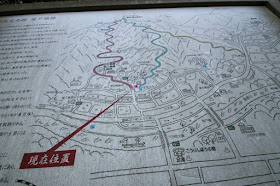







































































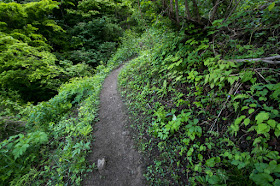
































































































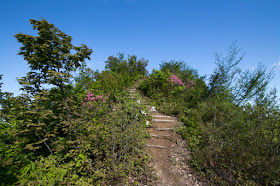
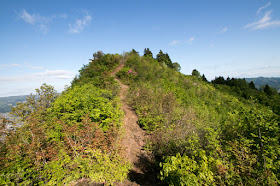






















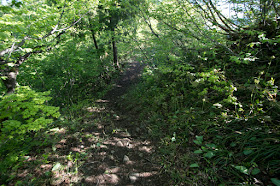




























































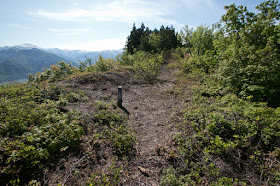

































No comments:
Post a Comment